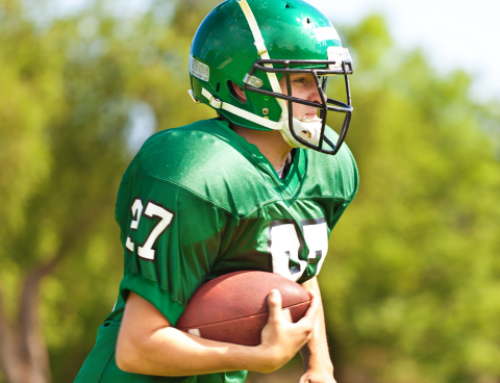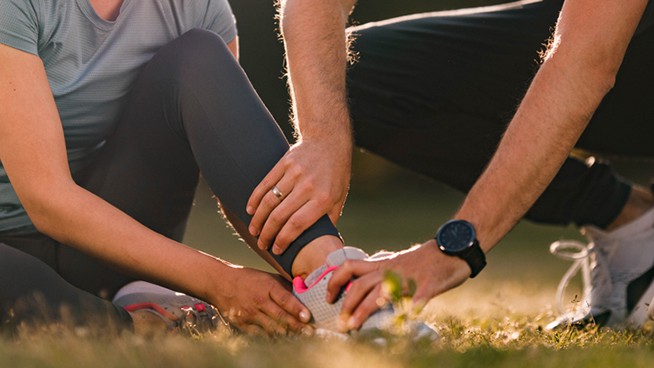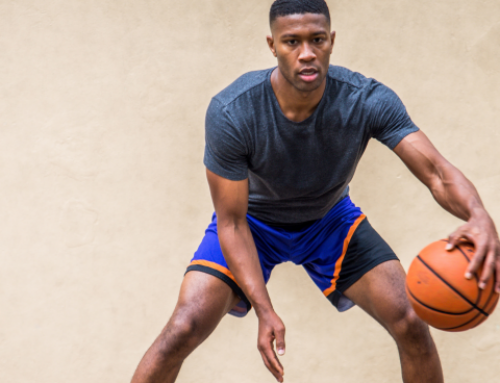Prevent ACL Injuries in Women’s Basketball with a Two-Step Deceleration Drill
There are several reasons why a female basketball player has a 50 percent greater likelihood of suffering a non-contact Anterior Cruciate Ligament (ACL) injury than her male counterparts. Many experts have different theories that focus on possible biomechanical differences, hormonal changes, poor neuromuscular integrated strength or a possible decrease in ligament tensile strength.
Along with these theories are also a few research facts that reflect:
- A higher degree of quadriceps dominance versus glute control which can predispose female athletes to a higher neuromuscular risk of injury.
- A greater valgus knee angle with lateral movements, which in turn places a greater strain on the medial compartment of the knee and the ACL.
- Less active knee and hip flexion during ground contact events like jumping and cutting, which in turn lessens deceleration control from the lower extremities and hips.
The fact is that 95 percent of all non-contact ACL injuries are a result of poor deceleration control of momentum and ground reaction sheer forces that occur as a result of change in direction. Sheer is a simultaneous application of a vertical, rotational and horizontal force that has been shown to be the exact force combination that results in the ACL being compromised. When evaluating strength and conditioning programs, especially in women’s basketball, it is the combination of a rotational and horizontal force vector that is often left untrained.
This is where flat continuously looped resistance bands can play a significant role in training. Resistance bands are essentially independent of gravity and therefore can create a true horizontal-rotational force vector when attached around the hips. Using this attached set-up to perform multi-directional 2-Step locomotion drills like shuffling, backpedals or crossovers allow female athletes to train as well as strengthen the body to effectively control sheer forces.
Over the past several years I have implemented a resistance band training program for women’s basketball players that we refer to as “2-Step Accelerated Deceleration” Drills.
These drills utilize a pair of linked up Quantum Bands to create an “accelerated deceleration” training momentum on the body that reflexively trains the body to handle increased momentum that in turn requires a faster deceleration response. Using short amplitude multi-directional movements allows athletes to gradually increase their band resistance which in turn increases the deceleration momentum velocity. As with any strength training program, as movement skills and strength improve, athletes develop a greater level of confidence in their deceleration footwork and strength.
The following videos demonstrate how to perform 2-Step Accelerated Deceleration Drills as it relates to a lateral, sagittal and rotational change of direction. Each of these drills require a pair of similar size 41-inch long continuously looped Quantum bands linked together using our Velcro link strap. This simple setup provides athletes with 4 yards of total training distance, which is more than enough to train two to three steps.
Shuffle 2-Step Deceleration
Backpedal 2-Step Deceleration
Crossover 2-Step Deceleration
READ MORE:
- The No. 1 Cause of Hamstring Injuries
- 7 Lessons Learned After Rehabbing and Training Through a Shoulder Injury
- The 8 Most Dangerous Exercises for Your Shoulders
RECOMMENDED FOR YOU
MOST POPULAR
Prevent ACL Injuries in Women’s Basketball with a Two-Step Deceleration Drill
There are several reasons why a female basketball player has a 50 percent greater likelihood of suffering a non-contact Anterior Cruciate Ligament (ACL) injury than her male counterparts. Many experts have different theories that focus on possible biomechanical differences, hormonal changes, poor neuromuscular integrated strength or a possible decrease in ligament tensile strength.
Along with these theories are also a few research facts that reflect:
- A higher degree of quadriceps dominance versus glute control which can predispose female athletes to a higher neuromuscular risk of injury.
- A greater valgus knee angle with lateral movements, which in turn places a greater strain on the medial compartment of the knee and the ACL.
- Less active knee and hip flexion during ground contact events like jumping and cutting, which in turn lessens deceleration control from the lower extremities and hips.
The fact is that 95 percent of all non-contact ACL injuries are a result of poor deceleration control of momentum and ground reaction sheer forces that occur as a result of change in direction. Sheer is a simultaneous application of a vertical, rotational and horizontal force that has been shown to be the exact force combination that results in the ACL being compromised. When evaluating strength and conditioning programs, especially in women’s basketball, it is the combination of a rotational and horizontal force vector that is often left untrained.
This is where flat continuously looped resistance bands can play a significant role in training. Resistance bands are essentially independent of gravity and therefore can create a true horizontal-rotational force vector when attached around the hips. Using this attached set-up to perform multi-directional 2-Step locomotion drills like shuffling, backpedals or crossovers allow female athletes to train as well as strengthen the body to effectively control sheer forces.
Over the past several years I have implemented a resistance band training program for women’s basketball players that we refer to as “2-Step Accelerated Deceleration” Drills.
These drills utilize a pair of linked up Quantum Bands to create an “accelerated deceleration” training momentum on the body that reflexively trains the body to handle increased momentum that in turn requires a faster deceleration response. Using short amplitude multi-directional movements allows athletes to gradually increase their band resistance which in turn increases the deceleration momentum velocity. As with any strength training program, as movement skills and strength improve, athletes develop a greater level of confidence in their deceleration footwork and strength.
The following videos demonstrate how to perform 2-Step Accelerated Deceleration Drills as it relates to a lateral, sagittal and rotational change of direction. Each of these drills require a pair of similar size 41-inch long continuously looped Quantum bands linked together using our Velcro link strap. This simple setup provides athletes with 4 yards of total training distance, which is more than enough to train two to three steps.
Shuffle 2-Step Deceleration
Backpedal 2-Step Deceleration
Crossover 2-Step Deceleration
READ MORE:
- The No. 1 Cause of Hamstring Injuries
- 7 Lessons Learned After Rehabbing and Training Through a Shoulder Injury
- The 8 Most Dangerous Exercises for Your Shoulders












